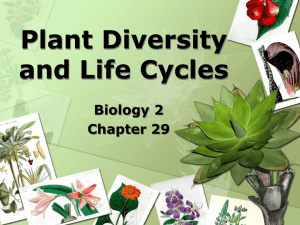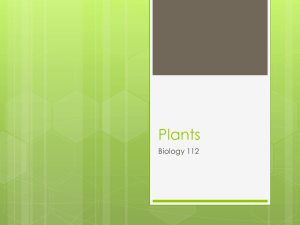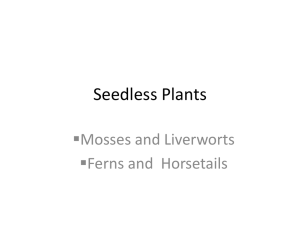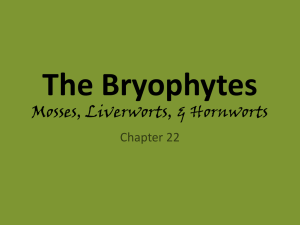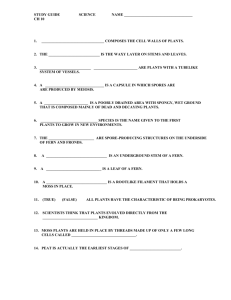Plants Unit chapter 4
advertisement
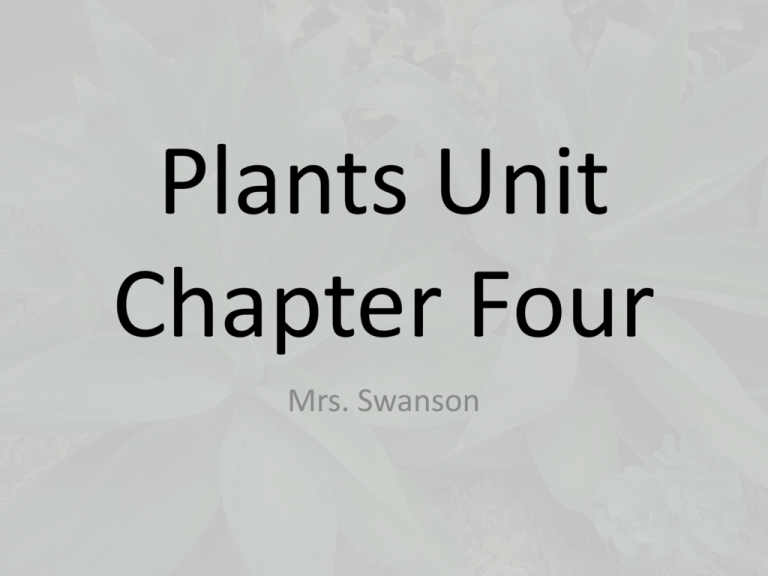
Plants Unit Chapter Four Mrs. Swanson What is a Plant? • I. The Plant Kingdom A. Autotrophic- Make their own food through Photosynthesis B. Multi-cellular- complex cells organized into tissues to transport materials. What is a Plant C. Cells1. Nucleus (eukaryote). 2. Chloroplasts- where food is made. 3. Vacuole- storage sac for water, waste, or food. 4. Diagram- pg. 105 http://www.phschool.com/webcodes10/index.cfm? wcprefix=cep&wcsuffix=1041&fuseaction=home. gotoWebCode&x=0&y=0 D. Adaptations for Living on Land 1. Obtaining Water 2.Retaining Water-cuticle covering the leaves 3.Transporting Materials- through vascular tissue 4.Support 5.Reproduction- Sexual E. Classification of Plants1. Nonvascular- lack a well-developed system of tubes for transporting water and materials. (No roots, thin cell walls, short) E. Classification of Plants2. Vascular- Well developed tubes to transport food, water, waste (Strong, stable, tall) F. Origins of Plants 1. 400 Million Years old. 2. Chlorophyll- Green Pigment found in the chloroplasts of plants, algae and some bacteria. G. Life Cycle p. 111 1. Sporophyte stage- plant produces spores that develop into new organisms. 2. Gametophyte stage- the plant produces two kinds of sex cells (sperm and egg). Sporophyte and Gametophyte II. Photosynthesis and Light A. Light 1. Transmission- light passes through 2. Reflection- Light bounces back 3. Absorption- Objects take in light. 4. When light strikes a green plant, most of the green is reflected, all other colors are absorbed. 5. Plant Pigment- chlorophyll absorbs light (reflects green) B. Photosynthesis Process 1. Capturing Energy-Chlorophyll traps light to make sugar an oxygen from carbon dioxide and water. Pg. 118 • http://www.pearsonsuccessnet.com/snpapp/i Text/products/0-13-1812386/video.html?fname=video/video_sx05_acv04 2.mov B. Photosynthesis Process 2.Photosynthesis Equation Carbon Dioxide + Water Sugar + Oxygen (CO2) + (H20) (C6H12O6) + (O2) http://www.phschool.com/webcodes10/index.c fm?wcprefix=cep&wcsuffix=1042&fuseaction= home.gotoWebCode&x=0&y=0 Characteristics of Vascular v. Nonvascular Characteristics Size Environment Body Parts Familiar Generation Is True Vascular tissue Present? Moss, Liverworts, Hornworts Fern, Club Mosses, and Horsetails Mosses • http://www.perspective.com/nature/plantae/ bryophytes.html Liverworts and Hornworts Ferns, Club Mosses, Horsetails Ancient Forests Characteristics of Vascular v. Nonvascular Characteristics Size Environment Body Parts Familiar Generation Is True Vascular tissue Present? Moss, Liverworts, Hornworts Fern, Club Mosses, and Horsetails Small and Low Can be Tall Moist Moist Rootlike, stemlike, and leaflike structures Gametophyte True roots, stems, and leaves NO Yes Sporophyte Fairy Tales and Nursery Rhymes • Today we are celebrating the unique differences between Mosses, Liverworts, and Ferns • Objective: Students will use their understanding of Non-Vascular plants to write and perform a nursery rhyme explaining each unique characteristic. Fairy Tales and Nursery Rhymes • Preparation: 10 minutes • Activity: 1. All Non-Vascular plants have a similar transport system for food, water, and waste. 2.Using your Plant Notes chart from yesterday, I will assign you one of the three Non-Vascular plants. 3.Choose a nursery rhyme and write the REAL words Fairy Tales and Nursery Rhymes 4.To help the class in reviewing the unique characteristics of your Non-Vascular plant, change the words of your nursery rhyme to words that describe your plant. (Use your journal) 5. Practice, Practice, and get ready to present your plant rhyme to the class. Nursery Rhyme Idea I'm a piece of algae in the ocean I sway. Where are my roots, stems, or leaves NOT TODAY! When I live in water asexual I stay. Red, Green, and Brown on any given day!

